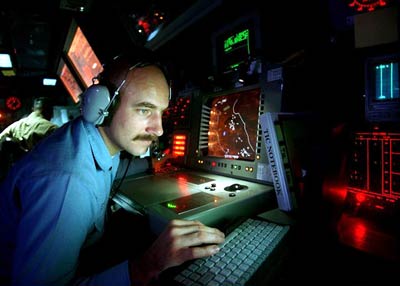Radar is something that is in use all around us, although it is normally invisible. Air traffic control uses radar to track planes both on the ground and in the air, and also to guide planes in for smooth landings. Police use radar to detect the speed of passing motorists. NASA uses radar to map the Earth and other planets, to track satellites and space debris and to help with things like docking and maneuvering. The military uses it to detect the enemy and to guide weapons.

Operation Specialist 2nd Class Gilbert Lundgren operates radar equipment in the combat information center of the USS Carney.
Meteorologists use radar to track storms, hurricanes and tornadoes. You even see a form of radar at many grocery stores when the doors open automatically! Obviously, radar is an extremely useful technology.
When people use radar, they are usually trying to accomplish one of three things:
- Detect the presence of an object at a distance - Usually the "something" is moving, like an airplane, but radar can also be used to detect stationary objects buried underground. In some cases, radar can identify an object as well; for example, it can identify the type of aircraft it has detected.
- Detect the speed of an object - This is the reason why police use radar.
- Map something - The space shuttle and orbiting satellites use something called Synthetic Aperture Radar to create detailed topographic maps of the surface of planets and moons.
All three of these activities can be accomplished using two things you may be familiar with from everyday life: echo and Doppler shift. These two concepts are easy to understand in the realm of sound because your ears hear echo and Doppler shift every day. Radar makes use of the same techniques using radio waves.


